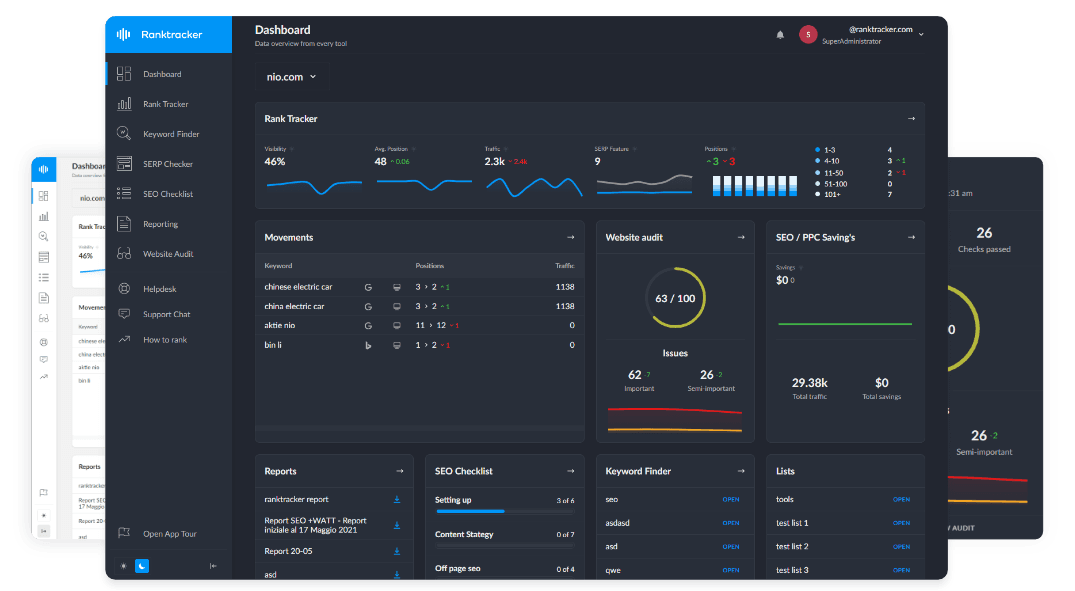Intro
Ecommerce SEO is the process of optimizing online stores to improve search visibility, traffic, and conversions. Unlike traditional SEO, ecommerce optimization focuses on product pages, category pages, and transactional intent to drive sales and engagement.
Why Ecommerce SEO Matters:
- Increases organic traffic & rankings for product listings.
- Boosts conversions by matching search intent with relevant pages.
- Reduces reliance on paid ads for long-term growth.
Key Ecommerce SEO Strategies
1. Keyword Research for Ecommerce Pages
- Target commercial & transactional keywords.
- Example:
- Informational: “Best wireless headphones for travel”
- Transactional: “Buy noise-canceling headphones online”
- Tools:
- Google Keyword Planner, Ahrefs, Ranktracker Keyword Finder
2. Optimize Product Pages for Search & Conversions
- Use keyword-rich product titles, descriptions, and meta tags.
- Example:
<title>Best Wireless Noise-Canceling Headphones – 40-Hour Battery</title>
<meta name="description" content="Buy the best wireless noise-canceling headphones with 40-hour battery life. Free shipping available.">
3. Implement Structured Data & Rich Snippets
- Helps Google display product reviews, pricing, and availability.
- Example:
{
"@context": "https://schema.org",
"@type": "Product",
"name": "Wireless Headphones",
"image": "https://example.com/headphones.jpg",
"description": "High-quality noise-canceling headphones with 40-hour battery life.",
"brand": {
"@type": "Brand",
"name": "TechSound"
},
"offers": {
"@type": "Offer",
"price": "199.99",
"priceCurrency": "USD",
"availability": "https://schema.org/InStock"
}
}
4. Optimize Category Pages for SEO & Navigation
- Include descriptive category names, internal links, and filters.
- Example:
<h1>Best Running Shoes for Men</h1>
<p>Discover the top-rated men's running shoes for performance and comfort.</p>
5. Improve Website Speed & Mobile Usability
- Use fast-loading images & mobile-friendly design.
- Tools:
- Google PageSpeed Insights, GTmetrix
6. Use Internal Linking & Breadcrumbs for Better Navigation
- Helps users and search engines find related products.
- Example:
<nav>
<a href="/home">Home</a> > <a href="/shoes">Shoes</a> > Running Shoes
</nav>
7. Enhance Image SEO with Alt Text & Compression
- Example:
<img src="headphones.jpg" alt="Wireless noise-canceling headphones with 40-hour battery">
8. Optimize Ecommerce Blog Content for Organic Traffic
- Write guides, comparisons, and how-to articles targeting long-tail queries.
- Example:
- "Best Wireless Headphones for Gym Workouts"
- "How to Choose the Right Running Shoes for Marathon Training"
9. Leverage Product Reviews & User-Generated Content
- Helps build E-A-T (Expertise, Authority, Trustworthiness).
- Example:
{
"@context": "https://schema.org",
"@type": "Review",
"reviewRating": {
"@type": "Rating",
"ratingValue": "5"
},
"author": {
"@type": "Person",
"name": "Jane Doe"
}
}
10. Fix Technical SEO Issues for Better Crawling & Indexing
- Ensure canonical tags, robots.txt, and sitemap optimization.
- Example:
<link rel="canonical" href="https://example.com/original-product-page">
Best Practices for Ecommerce SEO Success
✅ 1. Optimize for Mobile & Core Web Vitals
- Improve page speed, responsiveness, and user experience.
✅ 2. Build Authority with High-Quality Backlinks
- Get links from industry blogs, influencers, and product roundups.
✅ 3. Monitor Performance & Adjust Strategies
- Use Google Search Console & Ranktracker’s Web Audit Tool.
Tools to Optimize Ecommerce SEO
- Google Search Console – Monitor indexing & search performance.
- Ranktracker’s Web Audit Tool – Identify Ecommerce SEO gaps.
- SEMRush & Ahrefs – Analyze keyword rankings & competitor strategies.
Conclusion: Strengthening Ecommerce SEO for Higher Sales
A well-optimized Ecommerce SEO strategy enhances organic traffic, search rankings, and conversions. By focusing on product page optimization, structured data, and mobile-friendly experiences, online stores can maximize visibility and revenue.

